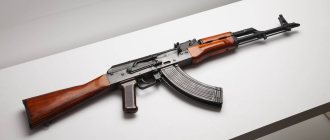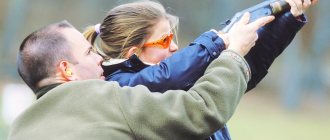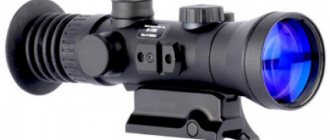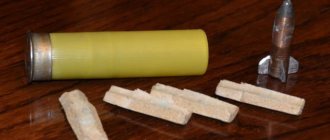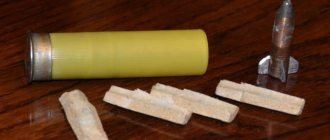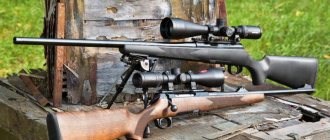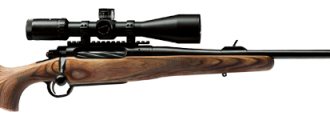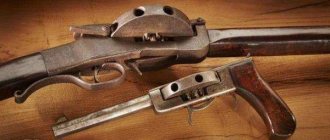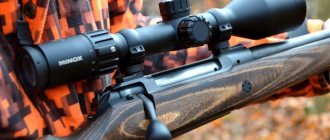Double-barrel shotguns with rifled barrels emerged following the rise in popularity of deer hunting in Scotland in the first half of the 19th century. Over time, they began to be used when hunting particularly large game.
In the modern world, rifled guns with one or two barrels that rotate on hinges are called fittings. The most popular model in Russia is the IZH18N fitting based on the IZH18 shotgun, which perfectly combines price and quality. The first fittings appeared in the 1830s, and their design was simple, and the charging process was very long - up to 10 minutes or more. Only about 50 years have passed, and the design of the “fractures” has come very close to the modern one.
One of the divisions of hunting fittings is into guns with soldered and free-floating barrels. They differ in the types of cartridges they can use. For soldered fittings, special bullets are required; for designs with free-floating barrels, any heavy or light weapon bullets are required. We will take a detailed look at the types of modern fittings and discuss their design features.
History of hunting fittings
The first fittings had many significant disadvantages - the muzzle-loading design did not allow the gun to be quickly reloaded. Fast charging was not feasible even after the invention of breech-loading models. The fittings operated on dangerous black powder, but due to their ballistics they ensured good bullet flight. And their price was quite affordable.
Over time, double-barreled guns appeared, with which the loading speed increased, and two bullets provided protection against misfire or an accidental miss. They began to use the breech loading system used in shotguns with a smooth barrel.
At the end of the 19th century, “express” fittings began to appear - fittings produced by the English armory of James Pedre Jr. They were divided into 2 types:
- with locks on the side boards - an elite, reliable weapon with a durable impact mechanism, an easy disassembly system and adjustable trigger mechanism;
- with Anson-Deely locks - budget but reliable fittings for the mass consumer.
In the 20th century, the design of the fittings changed slightly - spare strikers, a half-rib bar, a front forearm release button and other external changes appeared.
Weapon details
A single-shot rifle with a single barrel called MP18MN was designed by Izhevsk gunsmiths more than 20 years ago. The prototype of this carbine was the MP-18M-M smoothbore shotgun. Like any weapon made in Izhevsk, the fitting can also be designated by the abbreviation IZH, in this case – IZH 18 MN.
This weapon is widely distributed in Russian specialized stores. Most often you can find the IZH 18MN sample MP-18MN 308 Win, adapted for firing 7.62x51 caliber charges. A slightly less common variant is the MP-18MN 223 Rem, which fires 7.62x54R rounds. There are other modifications of this weapon, but it is difficult to find them in Russian stores.
Classification of modern fittings
The rifles are ideal for hunting large animals: moose, wild boars and bears, and in Africa - lions, rhinoceroses, buffaloes and other large representatives of the savannah. The best option for the structure of the fitting is 2 folding muzzles, allowing you to fire 2 consecutive shots of enormous force. Single-barrel rifle models are popular when hunting in the mountains, where the accuracy and range of the bullet is critical.
In Germany and Austria, they produce fittings with three and even four holes, which are suitable for hunting different types of game. Typically, 2 barrels are sharpened for large caliber, and the other for small caliber, for smaller game.
There are 3 main types of fittings and 1 additional one, which appeared relatively recently:
- Large-caliber models with a breaking mechanism, designed for oblong or round lead bullets. A historical obsolete type that is now almost never used. They were used together with black powder and gave a low bullet ejection speed - from 320 to 510 m/sec;
- Express type fittings. Breakthrough hunting rifles using bullets of different calibers (.450, .500, .577, etc.) without a jacket. To send them, black powder is used, the bullet's flight speed is in the range of 465 - 610 m/s;
- Nitroexpress - fittings for new jacketed bullets, which are sent using smokeless powder and develop speeds from 560 to 990 m/s;
- New bullpup fittings are small-caliber shotguns with one non-breakable barrel and a trigger, which is located in the middle of the weapon behind the firing mechanism. A compact model that has not lost any barrel length; loading with bullets occurs after the rear part of the butt is folded back. The stock is capable of storing additional ammunition.
The fittings are also divided according to the type of cartridges used - small-caliber European and large-caliber African.
The fitting is a weapon of professionals
09/29/2006 The personal preferences of the hunter play a certain role when choosing a weapon; there is, of course, another factor that is always taken into account, but which is not usually discussed. This is, of course, the price of the weapon.
A rifle is a weapon that is usually used when hunting large and dangerous animals. A mistake made in choosing a weapon for such hunts can be fatal. The hunter has to make a decision that will determine his future fate. But the practice of using weapons on African hunts, or more precisely on hunts where the hunter is exposed to the greatest danger, shows that the main weapon in this situation is a bolt-action rifle. Why is this happening? Why is the rifle not the main weapon of professional hunters and guides? The answer is simple, the reason until recently was the cost of such weapons as a fitting. But fortunately for the hunters, the situation has changed for the better. Therefore, now it is quite appropriate to remember what real advantages the fitting has over a bolt-on repeating rifle.
The first and main advantage is that the fitting makes it possible to fire two shots in a row without the risk of jamming. When shooting from a bolt-action rifle, the possibility of a cartridge jamming when feeding it from the magazine into the barrel must be taken into account. And, as a rule, this jamming can occur primarily due to the shooter, and not due to the fault of the rifle’s mechanisms.
When shooting at a dangerous animal while hunting, the shooter always experiences a lot of stress, as a result of which he makes very significant mistakes when reloading a weapon, which he would never make in a calm environment. Moreover, the weapon itself, which is operated in difficult climatic conditions, often fails. In the world of weapons designed for hunting dangerous animals, there are very few weapons that can function reliably in difficult conditions (heat, cold, heavy dust, etc.). Hunters who constantly practice shooting dangerous animals know this very well: in such situations, no brands of bolt-action rifles or semi-automatic rifles help.
If you have a double-barreled shotgun in your hands, then to fire the second shot you only need to pull the second trigger. If you have a double-barreled shotgun in your hands, then you actually have two single-shot rifles in your hands - two sears, two firing pins, two trigger mechanisms. Mechanical damage or failure of the trigger mechanism of a bolt-action rifle or semi-automatic will leave you unarmed; in the case of a double-barreled rifle, one working barrel will still remain at your disposal.
Another big advantage of fittings is their smaller size. A double barrel shotgun is always shorter and more compact than any rifle. This circumstance is especially important when hunting you have to hide game in dense thickets. Double-barreled rifles have good balance, excellent fit, and, as a result, high controllability, allowing you to make a quick and accurate shot.
The fitting, as a rule, is made to order, taking into account the individual anthropometric data of the shooter, i.e. in this type of weapon, adaptability is, as it were, programmed from the very beginning. The fitting has one more advantage that must be mentioned. A hunter with a fitting has the opportunity to load a cartridge with a non-expansive bullet into one barrel, and into the second - with an expansive bullet.
This will give the hunter the opportunity to flexibly react to the emerging situation during the hunt, which is very important when hunting for several types of game. The situation is very typical for driven hunts. The double-barreled rifle is a highly specialized weapon. It has no equal when hunting dangerous game at close and medium ranges.
The owner of the gun must understand well that when creating this type of weapon, the manufacturing company, as a rule, fires the barrels with a certain type of ammunition. The results of this shooting are entered into the weapon’s passport; the type of ammunition used for shooting is required to be indicated. When switching to another type of cartridge, it is necessary to check the firing of the weapon at a given distance.
All fittings are characterized by high strength barrel material, relatively short barrels providing increased maneuverability, a massive barrel block, a very durable and reliable locking mechanism, the mandatory presence of ejectors, a non-automatic safety and, of course, a fail-safe firing mechanism.
The listed requirements are fully satisfied by fittings with horizontal barrels “Merkel 140”, “Merkel 150” and “Merkel 160”. In terms of the level of performance, quality of materials used and combat, this weapon is not much inferior to similar fittings from well-known world companies, but costs much less. Nitroexpress fittings “Merkel 140” and “Merkel 150” have trigger mechanisms of a modified Anson Dilen system, and the “Merkel 160” model has “Goland-Goland” systems mounted on side boards.
All models have triple locking: a locking bar on two under-barrel hooks, a Perde frame and an upper Griner bolt. Fittings are manufactured only with ejectors. Barrels 630 mm long, made of special alloy steel, are cut to fit 13 types of choke cartridges. Open-type sighting devices are designed for a direct shot up to 150 m. Mounting places for installing an optical sight can be made upon request. Thanks to the powerful block and massive barrels, the weight of the weapon is at least 3.5 kg. The action of these fittings is excellent - flat, accurate and compact. This powerful weapon can be recommended for lovers of serious hunting. Merkel fittings have the best price-quality ratio in their class. If your desires are comparable to your financial capabilities, but you want only one thing - to own a real legend of the world of fittings, then you should pay attention to the weapons of the Heym Waffenfabrik company. The company produces fitting mod. 88. Every detail is on this fitting. The fitting block has a pad area 10-20% larger than that of most similar samples. Thus, according to the specific load when firing per unit area of the pillow and unit of length of the pillow, the “Heum” fitting mod. 88 with long cushions has a definite advantage. Fitting block "Neum" mod. 88 is designed long to withstand high loads when firing cartridges that develop pressures of 3600 kg.cm 2 or more.
Triple locking: double Perde frame and Griner bolt. The Perde frame is very wide and can withstand heavy loads.
The length of the barrels is 635 mm, the total weight of the fitting is from 3.7 kg to 4.5 kg or more. Fitting mod. 88 are produced for cartridges popular in Europe in calibers .30-06, 30R BLASER, 7x65R, 8x57IRS, 8x57RS, 9.3x74R, .375H&H Mag. and .375 FL. Mag.NE
The company produces a fitting for African hunting mod. 88 Safari for the following cartridges: 1 group - .375H&H Mag., .375FLMag.NE ., .300Win.Mag. and .458 Win.Mag. Group 2 - .416 Rigby, .450 NE, .470 NE, .500 NE Group 3 - .577 NE, .600 NE
In expensive versions of the mod. 88, backing locks are used on the side boards with a rear-mounted main washing spring.
Hunting weapons are easily recognized by the established German style of steel engraving.
In modern German engraving, three styles can be distinguished: relief, flat and “bulino”. Relief engraving and bulino style are performed only upon special order. The best engravers in Germany work here - Andreas Scholz and Michael Richter. All fittings are marked with multifaceted and skillful engraving.
Neum weapon stocks are made from high-grade Turkish walnut. Walnut wood is treated only with tinted oil. The company's rifled barrels are distinguished by high combat performance. At 100 m with an optical sight, the spread of hits does not exceed 40 mm. For custom weapons these values are even lower. When firing a quick doublet, the spread of hits should not exceed 70 mm. The survivability of barrels is sometimes 40% higher than that of barrels from other well-known German arms companies.
When choosing a weapon, remember that you have to use it. Having made your choice, you must constantly practice handling your weapon, shooting from it, feel its weaknesses, and try to turn them into advantages. It must be remembered that almost always when hunting dangerous animals, life is at stake, and, therefore, the weapon must fully meet the task.
Many years of experience in using various types of weapons on similar hunts clearly speaks in favor of a double-barreled rifle.
Design features of fittings
In essence, rifles are vertically or horizontally positioned guns for hunting, but with a rifled bore. Rifling mechanics allows you to send a bullet further, faster and more accurately. Instead, serious overpressure is created in the barrel, which is compensated by a reinforced bolt system.
Due to their heavy and thick barrels, as well as their overall reinforced design, fittings weigh more than their smoothbore counterparts, so using them on the move is not always convenient. The force of the shot from the “fractures” is such that with one shot it can easily kill any land animal, including an elephant. Even if the bullet does not kill the animal immediately, the energy of the shot will knock it down and paralyze it for some time. This effect is unattainable for other civilian weapons.
For the manufacture of large-caliber fittings, only the highest quality materials are suitable. A serious problem is to correctly bring two barrels together; they constantly strive to fire bullets in different directions. This happens due to internal pressure when fired; from the right barrel the bullet flies to the right, and from the left - to the left. The ideal result is when 2 bullets hit one 4-inch square target at a distance of 91 m (one yard).
The accuracy of the rifles is incomparable to the accuracy of single-barreled shotguns, but at medium and short distances this is not so important. Compounding the problem is the fact that guns are typically chambered for only one type of ammo. And even this type may differ slightly from one manufacturer to another, which will certainly affect the accuracy.
The problem of accuracy is somewhat solved by the technology of free-floating barrels - they are not soldered together, but are equipped with a system for adjusting the convergence of the axes of the barrel channels. This allows you to set them up to work with any type of cartridge manually. There are muzzle and middle fittings with free barrels, which are connected in different places by couplings or half-couplings. One of the barrels is attached rigidly to the coupling, and the other with a small gap, which allows you to adjust its position. There are also models with free barrels on a solid or muzzle tire.
The fittings are recommended for use only by experienced hunters. Due to their bulkiness, strong recoil, weight and lethality, they will be difficult for an amateur hunter to control.
About the technical characteristics of the fitting
The performance characteristics of the MR-18MN fitting are as follows:
- Its calibers are: 223 (with the 7.62x39 option), 308 (with the 62x54 option), 243 (with the 30x06 option), 222 and 270 (weapons with such calibers are mainly exported);
- 12 gauge barrel length is 72.5 cm;
- 16 gauge barrel length is 73.5 cm;
- For other calibers, the barrel length is from 67.5 to 68 cm;
- Chamber length – 76 mm;
- The total weight of the weapon is 2.6 - 2.8 kg.
With proper use and storage, the gun can be fired at least 8,000 times without making any major repairs.
Price for fittings and models made in Russia
A high-quality and reliable fitting is not cheap. The price tag is influenced by its type, manufacturer, caliber, technical condition and historical value of the model. You shouldn’t skimp on purchasing reliable “nitroexpress” fittings; the highest quality ones cost tens of thousands of dollars. But a model for 2-3 thousand dollars should be wary - there is a very high chance that such a fitting will fall apart after just a few shots. Large-caliber fittings designed for African hunting are even more expensive.
In Russia, fittings are not used so often. A possible reason is that there is no need to use their killing power; there are no acceptable targets for hunting. The most suitable target is a bear. But the fittings were in service with the army of the Russian Empire.
Currently, only a few worthy models of rifles are produced in Russia, among which the single-barrel IZH18N 12-gauge with a smooth removable barrel, the “double-barrel express” MP251 with a reliable and powerful locking unit, and the MP221 “Artemis” stand out. They are characterized by a small caliber, but are well suited for hunting any Russian animal.
The rifles are reliable and have serious stopping power, but they only have one or two shots. This does not allow for quick reloading, which can cost your life when hunting a dangerous predator. Previously, for backup, hunters used 2 guns at once, one of which was carried by the squire in case of emergency.
Now some manufacturers combine the heavy design of a double-barreled rifle with a magazine carbine, which allows you to fire shots up to 6 times in a row. Reloading is done simultaneously in both barrels. Such fittings weigh a lot and have serious dimensions, but provide a high level of safety when hunting.
Hartung fitting and others... Fittings of the 19th century. in service with the Russian fleet
Home "
From maykuduk. 03.11.2014 1203
0
in Favoritesin Favoritesfrom Favorites 0
Small arms with a smooth bore were significantly inferior to fittings in accuracy and firing range, so in the late 1830s the need arose to partially re-equip naval crews with rifled weapons. The advantages of rifled samples were obvious; the only thing that was confusing was the duration of muzzle loading. During this period, the “Committee for the Improvement of Fittings and Guns” created in Russia tested more than two dozen models of the most famous domestic and foreign designers and inventors of small arms. Among the tested samples, the design of Major General Berner of the Brunswick troops, developed back in 1832, was recognized as the best.
In 1840, the Russian Military Department ordered the Belgian manufacturers Falis and Trapman from the city of Littich (Liège) to produce fittings designed by Berner for the Guards Rifle Battalion of the Russian Army. Colonel Ignatiev was appointed observer for the implementation of this order. In total, 5,000 fittings were manufactured in Littych and sent to Russia, which were put into service under the name “Littich fitting of the 1843 model”.
The barrel of the fitting with a caliber of 7 lines (17.78 mm) and a length of 764 mm had two diametrically opposite grooves with a width of 7.49 and a depth of 0.63 mm, making a full turn along the length of the barrel. The weight of the barrel with the breech and the seed rod reached 2 kg. Initially, a spherical bullet of 6.7 line caliber with a leading belt with a diameter of 7.1 line and a bullet weight of 33 g was used for shooting. The charge of gunpowder in the cartridge was 5.33 g.
Initially, a spherical bullet with a leading belt with a diameter of 7.1 lines was used for shooting
Since 1849, a pointed bullet weighing 49.56 g with two protrusions (ears) began to be used for shooting from a fitting. This bullet was developed by Colonel Kulikovsky and had obvious advantages over its predecessor.
Since 1849, a pointed bullet with two protrusions (ears) began to be used for shooting from a fitting. This bullet was developed by Colonel Kulikovsky
The rifle's sights consisted of an iron front sight and a Hessian sight, which allowed for targeted shooting at a distance of 200 to 1,200 steps. Three loops are welded to the bottom of the barrel, with which it is attached to the stock.
Various design options for sights mounted on fittings. On top are two sights designed for shooting at a distance of up to 600 steps. The first of them is a flip-over shield, and the second is a folding shield with a fixed base, which is used for shooting at a distance of 200 steps. The bottommost one is the Hessian sight that replaced them, which made it possible to conduct aimed shooting at a distance of up to 1200 steps (the arrows indicate the direction of fire)
The stock of the fitting is made of walnut wood. The stock has a socket with a lockable copper lid for storing accessories. The iron ramrod is fixed at the bottom of the stock in two copper tubes, in which it is held by a ramrod spring. Attached to the fitting was a cleaver bayonet with a flat, double-edged blade and a cast brass hilt. The mass of the cleaver was 913 g. The total length of the fitting with the cleaver was 1,713 mm, and the weight was 5,285 g. The mass of the fitting without the bayonet was 4,389 g.
Each gun cost the Russian treasury 85 francs (excluding delivery costs and travel expenses). It should be noted that due to their high cost, these guns in Russia were used only for “target shooting”, and for maneuvers and linear exercises it was also necessary to have ordinary guns.
At the end of 1845, the main teacher of “one-piece shooting” of the Guards Corps, provincial secretary I.V. Hartung, proposed a method of converting smooth-bore dragoon rifles of the 1839 model into rifled ones using the Littikh fittings technology with the replacement of flintlocks with percussion cap locks. The main advantage of the proposed conversion method was the possibility of further use for combat purposes of obsolete weapons that had accumulated in large quantities in warehouses and arsenals.
Hartung fitting model 1839. One of the few surviving rarities
On the Hartung fitting, the flint lock was replaced by a percussion cap lock. The sight is set for shooting at a distance of 200 steps
An equally important argument was the cost of remaking each sample, which was three times lower in comparison with the Littikh fitting with similar combat qualities.
It must be said that today not every weapons specialist knows the design features of the Hartung fitting. In the process of searching for materials and illustrations for the article, the authors had to contact many museums in St. Petersburg, and only in the Military Historical Museum of Artillery, Engineering Troops and Signal Corps was discovered in the window of the main exhibition the only Hartung rifle, converted from a dragoon rifle of the 1839 caliber. 7.0 lines.
On the buttplate of the Hartung fitting there is a stamp depicting the Russian imperial coat of arms
Having received the Highest permission, in the artillery workshops, several samples of guns were remade using the Hartung method. The alteration included the manufacture of two rifling 7.49 mm wide and 0.63 mm deep, making 1¼ turns along the length of the barrel. The bullet weight was 49.5 g, and the rifle powder charge was 4.79 g.
The Hartung muzzle-loading fitting had the following technical characteristics:
– length with bayonet 171.9 cm, without bayonet – 132.8 cm; – weight with bayonet 4.15 kg, without bayonet – 3.37 kg; – barrel caliber 7 lines (17.78 mm); – trunk length 93.7 cm.
The rate of fire of the nozzle did not exceed 1-2 rounds per minute.
For the fitting, a lead pointed bullet (with two protrusions) with a diameter of 6.7 lines (17.02 mm), a length of 29.9 mm and a mass of 49.56 g was used. The combat charge of rifle powder was 4.80 g, blank 4, 27. The annual ammunition load for each fitting was: 100 combat, 150 combat training and 300 blank charges.
For every 10,000 rounds of ammunition, the following material supply standards were established:
– writing paper (standard sheets) 885 pcs. – wrapping paper – 266 sheets.
Capsules were issued at the rate of one primer for each cartridge; 20 capsules for every 100 fittings were supplied to the reserve. It was also planned to install a sight on the fitting, consisting of a vertical fixed shield with an upper slot for shooting at 200 steps and a rotating shield with holes for 300, 400 and 500 steps. A slot on the upper edge of the shield made it possible to conduct aimed fire at a distance of up to 600 steps (426 m).
The converted weapon was tested in the Finnish Life Guards Rifle Battalion and in the Separate Caucasian Corps, which gave good results. The accuracy of the combat of the Hartung and Littykh rifles in comparison with the dragoon rifle of the 1839 model can be judged from the data presented in the following tables. Accuracy of the 1839 model dragoon gun when firing spherical bullets. Accuracy of the Littikh rifle when firing spherical bullets with a belt. Accuracy of the littich rifle when firing pointed bullets with protrusions (ears). Accuracy of the Hartung gun when firing pointed bullets with protrusions (ears).
In addition to the above, tests were also carried out on the Black Sea in the 2nd naval training crew. Let us present the report of the commander of this crew, Captain 1st Rank Yukharin, to the Chief Commander of the Black Sea Fleet and ports: “Due to Your Excellency’s order No. 124 to test the Hartung fitting with the crew entrusted to me, I, together with the gentlemen staff officers, company commanders and artillery officers who are with the crew obviously, I tested the fitting and it turned out:
1) The fitting, being loaded similar to the instructions, according to the sight at 600 steps, hit below the target to a fathom distance, but the bullet entered the shield up to ½ inch (1.27 cm). 2) At 500 steps the bullet landed closer to the target, but still slightly below it. 3) At 400 steps - the same. 4) At 300 and 200 steps, the bullets hit the target each time or very close to it. 5) The direction of the bullet is close to the sight line. 6) The number of steps is measured, taking a step as an arshin. 7) The recoil of the nozzle when fired is barely noticeable and in no way more than the recoil of an ordinary gun. The shots were fired from a bipod. 9) Handling the fitting when loading requires special care when releasing the trigger on an applied primer. I have the honor to return the sent fitting.”
2) At 500 steps the bullet landed closer to the target, but still slightly below it. 3) At 400 steps - the same. 4) At 300 and 200 steps, the bullets hit the target each time or very close to it. 5) The direction of the bullet is close to the sight line. 6) The number of steps is measured, taking a step as an arshin. 7) The recoil of the nozzle when fired is barely noticeable and in no way more than the recoil of an ordinary gun. The shots were fired from a bipod. 9) Handling the fitting when loading requires special care when releasing the trigger on an applied primer. I have the honor to return the sent fitting.”
On April 14, 1847, the Hartung fitting was submitted to the Highest consideration, where it received the full approval of the emperor. Emperor Nicholas I ordered that exact patterns of the presented sample be made and transferred to arms factories for subsequent reworking “... so that everything would be similar to the sample.”
The sample fitting was disassembled into its component elements, from which patterns were made. Both master manufacturers and weapon receivers had to have patterns. The alteration included replacing the lock from a flintlock to a percussion cap.
In addition to the low cost and the possibility of further use of old stocks of weapons, another positive point was achieved - the same cartridge could be used in the Littych fitting and the Hartung fitting. For both the Littich and the Hartung fittings, a cartridge in a paper sleeve was used, loaded with 4.8 g of rifle powder and a pointed lead bullet with two protrusions. The bullet had the following characteristics: diameter at the base - 6.7 lines (17.02 mm) along the protrusions - 7.1 lines (18.03 mm), bullet length 29.9 mm, weight 49.5 g. Standard ammunition (annual ) for the Hartung fitting was 100 combat, 150 combat training and 30 training blank cartridges.
Muzzle with two rifling bore. At the bottom of the muzzle there is a metal boss for attaching a bayonet
Soon, at the Sestroretsk Arms Factory (using patterns), a “model” fitting was made (its cost was 9 rubles 75 ¾ kopecks in silver), which was tested in the 2nd Naval Training Crew. In 1848, the Hartung fitting was adopted by the army and navy.
Bayonet for the Hartung fitting Bayonet for the Littikh fitting mod. 1843
Considering the unfavorable state of affairs with the armament of ship crews of the Black Sea Fleet, the fitting, together with the test report, was sent to the city of Nikolaev. The Chief Commander of the Black Sea Fleet and ports, Adjutant General Admiral M.P. Lazarev, in his letter to the Chief Intendant (No. 83316 dated December 22, 1849) reported that “The Emperor deigned to order the installation of a Hartung fitting gradually in naval crews.” It was also reported here that at the Sestroretsk plant, converting a dragoon gun into a Hartung fitting would cost 3 rubles 58 kopecks. silver In his subsequent letter (No. 2189 dated June 5, 1850), the Commander of the Black Sea Fleet and Ports gave orders to the Chief Intendant “... to manufacture it on the ships of the 1st and 2nd naval brigades.”
In the same year, the first batch of Hartung fittings, numbering 288 units, was ordered from the Tula Arms Plant. In addition to the fittings, the production of 12 bullet molds was ordered at a cost of 6 rubles. 90 kopecks (at the rate of 1 bullet and a pickle for every 24 fittings).
Taking into account the relative high cost of the conversion and the acquired experience of arming skirmishers of guards corps battalions with rifles (24 pieces each), it was planned to issue 24 Hartung rifles to each ship. They were supposed to be used during landing operations and to defeat enemy personnel located in open areas of the ship at the approach distances of boarding ships.
With his letter No. 2150 dated May 6, 1853, the head of the Tula Arms Factory, Major General Samson, confirmed the receipt of a “model” fitting and money for the production of 288 units. However, already on August 22, 1853, the Chief of the Main Naval Staff, Admiral A. S. Menshikov, notified the Chief Commander of the Black Sea Fleet and Ports that the War Ministry did not approve the further production of Hartung fittings and recommended stopping their production.
In this regard, the command of the Black Sea Fleet decided to speed up the delivery of weapons already manufactured at the Tula plant. Having received this instruction, the representative of the fleet, Lieutenant Evdokimov, who was in Tula, in October 1853, hastily accepted from the factory 288 fittings already manufactured, complete with 12 bullet molds and accessories, which (together with the “model” copy) under the supervision of private 25th company Ivan Eresk sent in troikas (relay race) to Sevastopol.
Later, the Chief Commander of the Black Sea Fleet and Ports received a report from the commander of the 5th naval division that the 38th, 39th, 40th, 41st, 44th, and 45th ship crews were equipped with fittings (24 pieces each) and equipment for them. And yet, by the beginning of the Crimean (Eastern) War of 1853-1856. Some naval crews were left without rifled small arms. For the sake of objectivity, it should be noted that the weapons of the Russian army and navy during the Crimean campaign differed significantly for the worse from the weapons of the enemy. For example, in the Eastern War, three regiments of zouaves and five battalions of rangers had rifled guns. As for the British, their troops were indeed fully armed with rifled rifles of the Anfield system. The very noticeable difference in the firing range of rifled and smooth-bore small arms allowed the enemy to inflict significant damage on Russian troops, hitting soldiers, artillery servants and horses at a distance of up to 1200 steps, while weapons with a smooth bore had a significantly shorter firing range.
Fatal wound of Admiral P.S. Nakhimov by a rifle bullet during the defense of Sevastopol
The Minister of War, being well aware of the incomplete supply of small arms to the ship crews of the Baltic Fleet, sent a letter to the Administrator of the Naval Department on January 23, 1854: “... I have the honor to inform you that in case it would be considered useful, due to the current lack of Littych fittings , supply the fleet with guns of the Hartung system, then the War Ministry can release: 250 pcs. and at the end of May or at the beginning of June another 250, after they are manufactured at the Izhevsk plant.” Three days later, a response was received from the Admiral General, Grand Duke Konstantin Nikolaevich, Admiral General of the Maritime Ministry: “The Maritime Ministry will accept the 500 Hartung fittings proposed for release from the Land Department to the Maritime Department with gratitude. I ask you to give an order to release the said guns to the jurisdiction of the Artillery Department of the Naval Ministry, within the time frame that the land department finds convenient for itself.”
Soon the Highest permission was received to transfer 500 Hartung fittings from the land department to the naval department. Based on the decision made, the Artillery Department of the War Department gave the following orders:
"1. From the Izhevsk Arms Plant, send 250 fittings with 10 bullet molds for casting pointed bullets, 25 presses and 10 screw boards to Moscow, with the expectation that they arrive there by May 15, and from there they are transported by rail to St. Petersburg and put under the jurisdiction of the one who will be appointed to receive them from the Artillery Department of the Naval Ministry.
2. From the St. Petersburg Arsenal, assign for release now to the Artillery Department of the Naval Ministry, consisting of 135 fittings, and the remaining 115 as received from the Sestroretsk plant and from the regiments.
3. The following 10 bullet molds, 10 screw plates and 25 pressures for these last fittings, as well as 500 spare seed rods for all fittings must be delivered to the arsenal from the Sestroretsk plant for delivery to the receiver of the Maritime Department. At the same time, 10 printed copies of a description of the preparation of cartridges with a pointed bullet, adopted for the Hartung fitting, are attached.”
At the beginning of February 1854, the Administrator of the Naval Ministry, Grand Duke Konstantin Nikolaevich, received an order to the quartermaster general of the fleet: “... from among those appointed for release from the St. Petersburg (land) arsenal - 135 and sent from the Sestroretsk plant - 115 fittings, send: 140 to Kronstadt, 30 - to St. Petersburg, 10 pieces each to the crews of the 1st and 2nd Divisions (except the 16th) and to the 25th crew; Transfer 80 fittings to Sveaborg, to supply them in 10 pieces. crews of the 3rd Division and the 3rd crew."
By order of the Artillery Department of the Naval Ministry, the commander of Arsenal Company No. 1, Captain Popov, who was assigned for special assignments to the Artillery Department of the Naval Ministry, reported in his report dated February 22, 1854: “I have received from the St. Petersburg Arsenal - 135 Hartung fittings with bayonets and ramrods ( without pyzhevniks)”, as well as “... with accessories: screwdrivers for weapons - 135, seeding agents - 135, pressures - 25, bayonet sheaths 135, molds for casting pointed bullets - 10, screw boards - 10 and spare seeding rods - 500.”
The Artillery Department immediately ordered the commander of the 1st Arsenal Company to release, from among those received from the ground arsenal, naval crews 13, 15 and 17, 10 each: fittings, leather capsule bags and spare primer rods. For naval crews 3, 19, 20, 22, 23, 24, 26 and 27, wintering in Sveaborg, 80 fittings were sent; for the 3rd crew to Kronstadt - 25 and to St. Petersburg 30 fittings. In March, Captain Popov accepted from the Sestroretsk plant 74 repaired fittings complete with cleaning rods, bayonets and scabbards, screwdrivers and pickles, which were immediately distributed among the naval crews.
Thus, the Hartung fitting, as well as the blunderbusses, became the last examples of obsolete equipment before the complete re-equipment of fleet vessels with more advanced rifled small arms.
source: Igor Sukhanov, Marina Khaburzania Kalashnikov Magazine 2003, No. 6.
About the advantages and disadvantages of a gun
Every weapon has exclusive advantages over other similar weapons, as well as unique disadvantages. The MR-18MN fitting is no exception. It also has its own advantages and disadvantages.
First, let's talk about the advantages. The weapon has excellent shooting accuracy. The fitting is simple in design and easy to maintain. It works great in hot and cold weather, as well as when there is excessive humidity. In addition, compared to other brands of hunting weapons, the fitting is extremely cheap.
Now about the disadvantages. According to user reviews, the most annoying drawback of this weapon is that it has an excessively hard and loud trigger. In addition, when using domestic charges, repeated misfires occur. In addition, the butt of the weapon and other wooden parts are often cracked and burred.
Weapon tuning and its price
It has already been mentioned that the rifle-type gun labeled MP-18MN is one of the cheapest domestic hunting models. Its minimum cost is about $140. The maximum cost is about $335. The price range depends mainly on the caliber of the weapon.
Apart from different calibers and interchangeable barrels, the manufacturer does not propose any other improvements for this weapon. We can say that to this day the fitting remains in its original form, so there is plenty for tuning lovers to roam around here. Moreover, the weapon, as already mentioned, has a rather sloppy appearance.
This primarily concerns the butt and other wooden parts. Scratches, cracks and chips can be found on many stocks. In addition, the stock may be poorly polished. Sanding the wooden parts of weapons is the main part of tuning this weapon. By the way, the latest MP-18MN models are available with plastic stocks, but the cost of such models is slightly higher.
